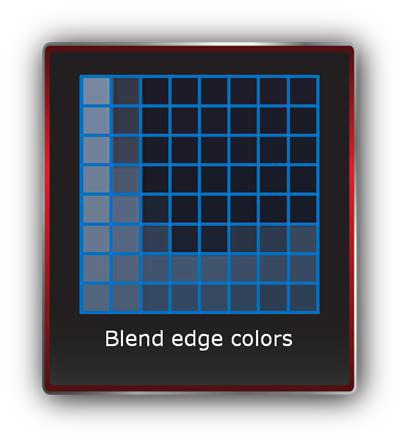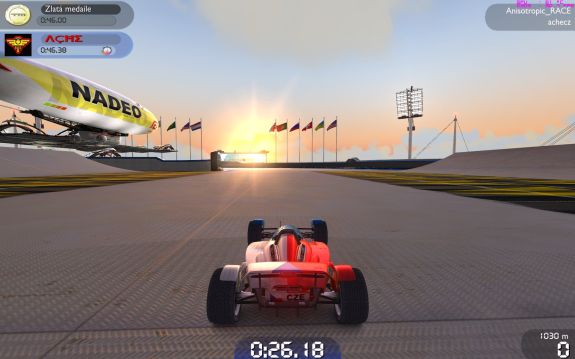AMD’s Radeon HD 6870 & 6850: Renewing Competition in the Mid-Range Market
by Ryan Smith on October 21, 2010 10:08 PM ESTHigh IQ: AMD Fixes Texture Filtering and Adds Morphological AA
“There’s nowhere left to go for quality beyond angle-independent filtering at the moment.”
With the launch of the 5800 series last year, I had high praise for AMD’s anisotropic filtering. AMD brought truly angle-independent filtering to gaming (and are still the only game in town), putting an end to angle-dependent deficiencies and especially AMD’s poor AF on the 4800 series. At both the 5800 series launch and the GTX 480 launch, I’ve said that I’ve been unable to find a meaningful difference or deficiency in AMD’s filtering quality, and NVIDIA was only deficienct by being not quite angle-independent. I have held – and continued to hold until last week – the opinion that there’s no practical difference between the two.
It turns out I was wrong. Whoops.
The same week as when I went down to Los Angeles for AMD’s 6800 series press event, a reader sent me a link to a couple of forum topics discussing AF quality. While I still think most of the differences are superficial, there was one shot comparing AMD and NVIDIA that caught my attention: Trackmania.
The shot clearly shows a transition between mipmaps on the road, something filtering is supposed to resolve. In this case it’s not a superficial difference; it’s very noticeable and very annoying.
AMD appears to agree with everyone else. As it turns out their texture mapping units on the 5000 series really do have an issue with texture filtering, specifically when it comes to “noisy” textures with complex regular patterns. AMD’s texture filtering algorithm was stumbling here and not properly blending the transitions between the mipmaps of these textures, resulting in the kind of visible transitions that we saw in the above Trackmania screenshot.

| Radeon HD 5870 | Radeon HD 6870 | GeForce GTX 480 |
So for the 6800 series, AMD has refined their texture filtering algorithm to better handle this case. Highly regular textures are now filtered properly so that there’s no longer a visible transition between them. As was the case when AMD added angle-independent filtering we can’t test the performance impact of this since we don’t have the ability to enable/disable this new filtering algorithm, but it should be free or close to it. In any case it doesn’t compromise AMD’s existing filtering features, and goes hand-in-hand with their existing angle-independent filtering.
At this point we’re still working on recreating the Trackmania scenario for a proper comparison (which we’ll add to this article when it’s done), but so far it looks good – we aren’t seeing the clear texture transitions that we do on the 5800 series. In an attempt to not make another foolish claim I’m not going to call it perfect, but from our testing we can’t find any clear game examples of where the 6870’s texture filtering is deficient compared to NVIDIA’s – they seem to be equals once again. And even the 5870 with its regular texture problem still does well in everything we’ve tested except Trackmania. As a result I don’t believe this change will be the deciding factor for most people besides the hardcore Trackmania players, but it’s always great to see progress on the texture filtering front.
Moving on from filtering, there’s the matter of anti-aliasing. AMD’s AA advantage from the launch of the 5800 series has evaporated over the last year with the introduction of the GeForce 400 series. With the GTX 480’s first major driver update we saw NVIDIA enable their transparency supersampling mode for DX10 games, on top of their existing ability to use CSAA coverage samples for Alpha To Coverage sampling. The result was that under DX10 NVIDIA has a clear advantage in heavily aliased games such as Crysis and Bad Company 2, where TrSS could smooth out many of the jaggies for a moderate but reasonable performance hit.
For the 6800 series AMD is once again working on their AA quality. While not necessarily a response to NVIDIA’s DX10/DX11 TrSS/SSAA abilities, AMD is introducing a new AA mode, Morphological Anti-Aliasing (MLAA), which should make them competitive with NVIDIA on DX10/DX11 games.
In a nutshell, MLAA is a post-process anti-aliasing filter. Traditional AA modes operate on an image before it’s done rendering and all of the rendering data is thrown away; MSAA for example works on polygon edges, and even TrSS needs to know where alpha covered textures are. MLAA on the other hand is applied to the final image after rendering, with no background knowledge of how it’s rendered. Specifically MLAA is looking for certain types of high-contrast boundaries, and when it finds them it treats them as if they were an aliasing artifact and blends the surrounding pixels to reduce the contrast and remove the aliasing.


MLAA is not a new AA method, but it is the first time we’re seeing it on a PC video card. It’s already in use on video game consoles, where it’s a cheap way to implement AA without requiring the kind of memory bandwidth MSAA requires. In fact it’s an all-around cheap way to perform AA, as it doesn’t require too much computational time either.
For the 6800 series, AMD is implementing MLAA as the ultimate solution to anti-aliasing. Because it’s a post-processing filter, it is API-agonistic, and will work with everything. Deferred rendering? Check. Alpha textures? Done. Screwball games like Bad Company 2 that alias everywhere? Can do! And it should be fast too; AMD says it’s no worse than tier Edge Detect AA mode.
So what’s the catch? The catch is that it’s a post-processing filter; it’s not genuine anti-aliasing as we know it because it’s not operating on the scene as its being rendered. Where traditional AA uses the rendering data to determine exactly what, where, and how to anti-alias things, MLAA is effectively a best-guess at anti-aliasing the final image. Based on what we’ve seen so far we expect that it’s going to try to anti-alias things from time to time that don’t need it, and that the resulting edges won’t be quite as well blended as with MSAA/SSAA. SSAA is still going to offer the best image quality (and this is something AMD has available under DX9), while MSAA + transparency/adaptive anti-aliasing will be the next best method.
Unfortunately AMD only delivered the drivers that enable MLAA yesterday, so we haven’t had a chance to go over the quality of MLAA in-depth. As it’s a post-processing filter we can actually see exactly how it affects images (AMD provides a handy tool to do this) so we’ll update this article shortly with our findings.
Finally, for those of you curious how this is being handled internally, this is actually being done by AMD’s drivers through a DirectCompute shader. Furthermore they’re taking heavy advantage of the Local Data Store of their SIMD design to keep adjacent pixels in memory to speed it up, with this being the biggest reason why it has such a low amount of overhead. Since it’s a Compute Shader, this also means that it should be capable of being back-ported to the 5000 series, although AMD has not committed to this yet. There doesn’t appear to be a technical reason why this isn’t possible, so ultimately it’s up to AMD and if they want to use it to drive 6800 series sales over 5000 series sales.











197 Comments
View All Comments
Parhel - Friday, October 22, 2010 - link
That's the truth. And even worse is that, after this review, I can no longer trust Anandtech as an unbiased review site. Along with the cards arriving on their doorsteps, NVidia tells the review sites which settings to use for both their own cards and AMD's. If the FTW edition card was included, I have to assume that the 'special' settings were used as well, which invalidates this whole article. Cementing that position is that HardOCP, I site I trust 100% but which is not one of my favorites, shows the new AMD cards performing MUCH better than we see them on Anandtech.spigzone - Friday, October 22, 2010 - link
I doubt Nvidia even tried to roll Kyle.What's more pathetic than someone knowing they are being rolled and trying to rationalize why it's okay as it's happening as if to say 'see, I'm TELLING you I'm getting rolled, so I DO have integrity ... you can see that, can't you???
Thank god for the Kyles of the world to provide integrity benchmarks.
Lolimaster - Sunday, October 24, 2010 - link
Is not even unbiased towards AMD cpu's. This explain everything.Trully PATHETIC
Will Robinson - Friday, October 22, 2010 - link
It actually doesn't matter that much.After reading all the reviews out its pretty clear both the 6850 and 6870 are damn good cards and have some great new features.You can run 6 screens off one card,each at different resolutions,refresh rate and orientation.
That's pretty awesome.
NVDA obviously prefers a highly overclocked card to be used in the benchmarking but its pretty clear who the winners are.
Crossfire scaling and performance looks very nice....these new cards the new mid range champs.
Manu64 - Friday, October 22, 2010 - link
So far i've always valued Anandtech as a neutral PC site, now i'm losing my faith... Whole article written in favor of NVDA because of an heavily overclocked card? You are losing your standards :-(Jamahl - Friday, October 22, 2010 - link
I must agree. The whole front page bangs on about how Anandtech never uses overclocked cards blah blah, then throws it out the window.Anandtech hits an all time low.
kmmatney - Friday, October 22, 2010 - link
I don't mind an overclocked card - its a card you can buy right now on NewEgg, so its a valid option. HOWEVER, it would have been much better to at least give an odea of how the new ATi cards overclock.mac2j - Friday, October 22, 2010 - link
I also don't think the 460 (OC) belonged in this article.Compare reference to reference .
Compare the custom 6850s to custom 450s/460s.
Compare the custom 6870s which are coming later to OC 460s/470s.
Are the 6950/6970 going to have to beat the Point of View TGT GTX480 beast or the N480GTX Lightning from MSI? Cards built on limited numbers of hand-selected chips and custom overclocked?
It's pretty ridiculous what you did ... and didn't even mention the possible future advantages of these cards thanks to them having Displayport 1.2 support.
mindbomb - Friday, October 22, 2010 - link
I disagree.When the gtx 460 1gb OC models price is around the price of a regular 6870, you can compare them.
bji - Friday, October 22, 2010 - link
Finally some reasonable logic in this panties-in-a-bunch fest.